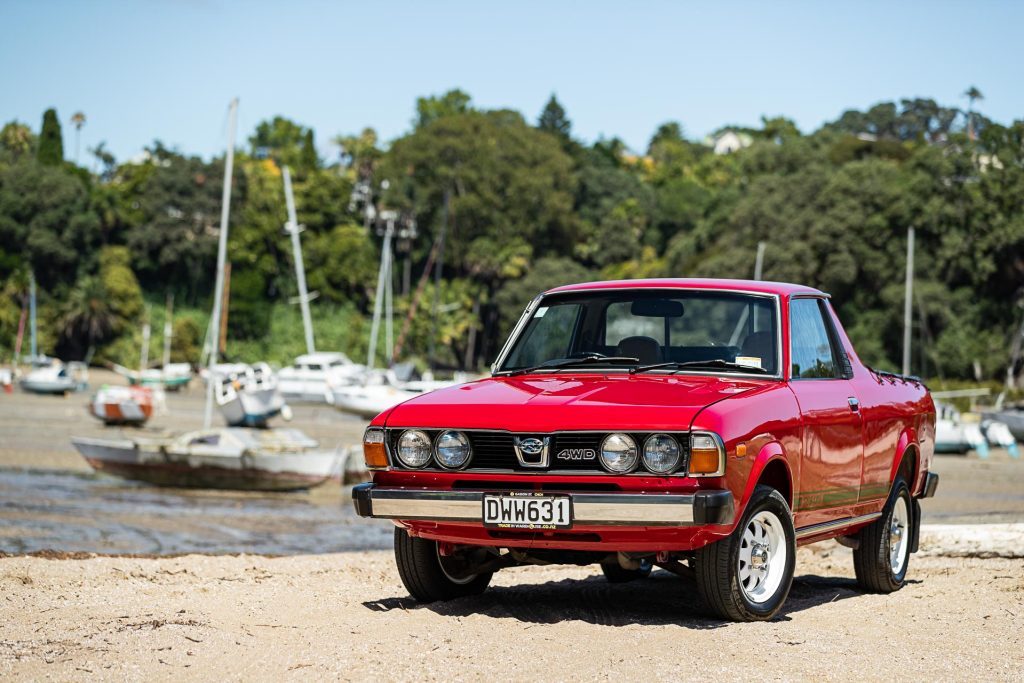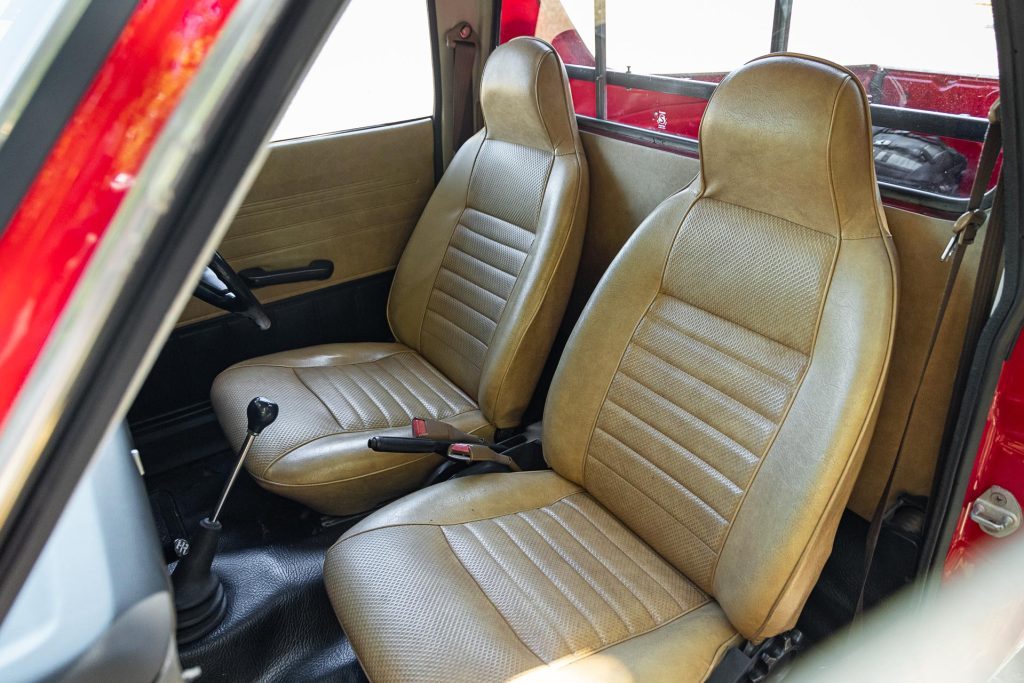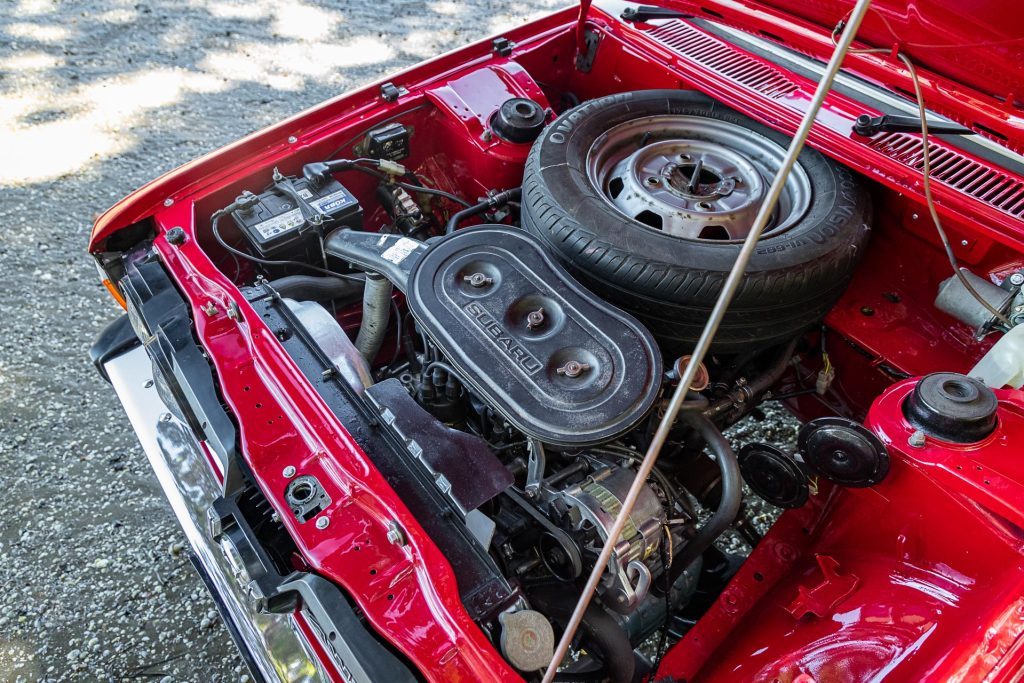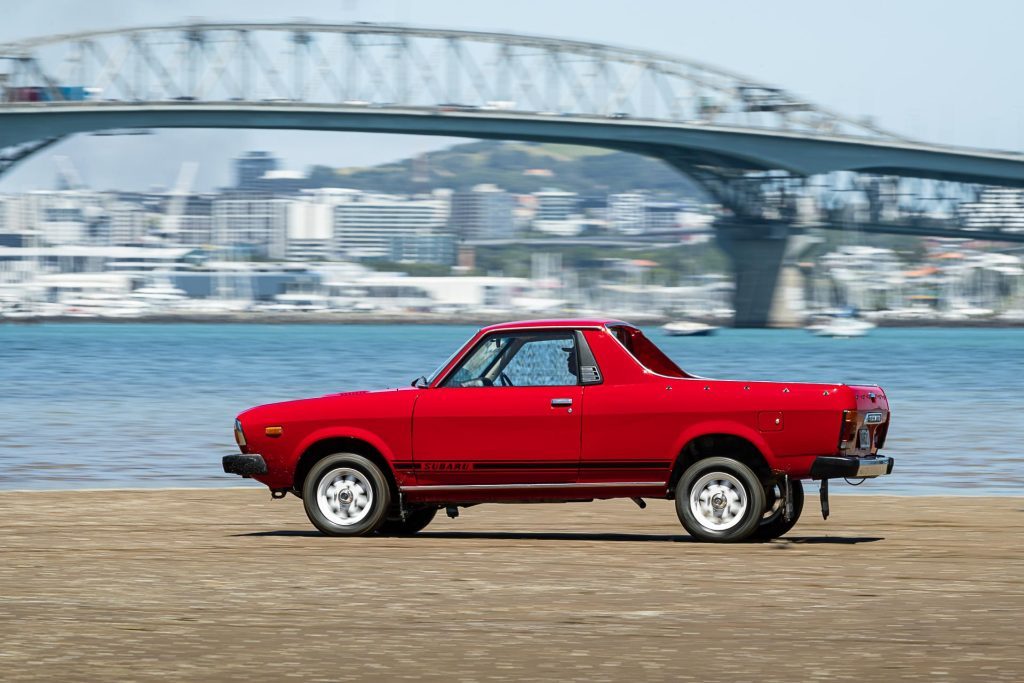1981 Subaru Brumby
Words: Kyle Cassidy | Photos: Isaac Western
Subaru is renowned for its AWD vehicles, not for its pick-up trucks. But the Japanese firm did turn out a utility vehicle once, and they even made it right here in New Zealand.
You probably remember back to when Subaru made a ute, and that it was sold new here in New Zealand. But what was it called?
Most would say Brumby but originally it was sold here as the MVP, or MV Pick-up, which is what appears on the rego papers of this 1981 Subaru.

And another interesting fact, this red beauty was made here too, assembled by Motor Industries International (a subsidiary of Motor Holdings Ltd) in its Waitara plant in Taranaki.
Subaru’s little ute that could was developed in Japan in 1977 at the request of Subaru America. There was a niche forming in the North American market for compact ‘trucks’ following the various oil shocks.
Instead of developing something from scratch, the canny Subaru engineers used the underpinnings and drivetrain of its existing Leone station wagon.

In the US, it was called the BRAT, which stood for Bi-drive Recreational All-terrain Transporter. Its AWD capabilities were a unique selling point, especially in wintry states and provinces of North America.
It was introduced in 1978 and the coupe utility caught on, its impressive fuel economy a boon in times of expensive gas.

Another interesting fact; Subaru America added a pair of rearward facing seats in the tray in order to have the BRAT classified as a passenger vehicle.
This allowed it to circumvent a 25 per cent tax levied against imported utility vehicles.

Though developed and made in Japan, it was never sold in its domestic market, as buyers had no appetite for such a vehicle but it was sold in some European markets, throughout South America, Africa and also the Antipodes.
It went by a few different names too; Brumby, Shifter as well as MVP.
This shiny red truck is owned by Japanese ex-pat and Subaru enthusiast, Tom Ukai, who was glad to get the chance to purchase this unique model.

“I first saw this car on Trade Me when I was living in Japan a few years ago. This model had us Subaru enthusiasts in Japan quite excited because it was a first-generation model but with an 1800cc engine.
We didn’t know such a thing existed.” As Tom was still living in Japan at the time, he wasn’t able to bid on it and the Subaru was sold.
However, a few years down the track and now living in New Zealand, he was surprised to see it pop back up on Trade Me again. “I couldn’t pass on it.”

He bought it in an ‘okay condition’ but has since patched up a few rust spots around the body and rectified the faded paint. A few other parts he sourced from Japan while others came from Israel, of all places.
Tom tells us this was the last year of the first-generation body. Initially, the MVP was powered by Subaru’s EA series flat-four with a displacement of 1600cc.
This offered up 50kW with 110Nm of torque and was matched to a four-speed manual.

Thankfully the little pick-up only weighed 990kg but, as Tom puts it, ‘the 1600 didn’t go very well’. From 1981 it was upgraded with an 1800cc engine, the increase in stroke taking power to 54kW and torque to 128Nm, made lower down in the engine range.
From the mid-eighties, it could be had with a turbocharged 1.8 (70kW and 166Nm) in some markets, along with the option of a three-speed auto.

The MVP has a switchable, part-time four-wheel drive set-up. It’s a front driver until the 4WD lever is pulled, locking the drivetrain in a 50:50 torque split.
There’s no centre differential, the drive connecting directly with the rear differential.

As such, Tom says it can be a bit hard to turn with a full lock of steering, the driveline binding up. While the early models all had a single-range transfer case, a dual-range set up with a lower ratio setting was ushered in with the introduction of the 1800cc.

Being Leone based, it has a unibody construction with Mac struts up front, rack and pinion steering and an independent torsion bar-sprung rear end.
That made it unique among the more usual rear-drive, body-on-frame construction of other small pick-ups. Opening up the bonnet, you’ll find the boxer engine is hung out well forward of the axle, the drive coming straight out of the transmission in behind.

It’s so far forward that there’s room on top of the transmission for the spare wheel. Thankfully it’s an all alloy engine, said to weigh less than 100kg.
Tom says this makes for rather unique driving characteristics. “Compared with other small pick-ups, this drives more like a car. It’s a bit front heavy with the engine where it is, and that gives it a unique feeling when you make a turn.

I quite like it, once you get used to it. It’s light in the rear, so it’s quite nimble, a lively machine to drive.”
Tom likes the look of the ute too, the way the B pillar sweeps down and integrates the cab with the tray harmoniously.

“The early Subaru cars aren’t great looking. Because of the engine position, the front overhang looks too long while they are quite short at the rear. But they got the look of the ute right. It’s longer, so has better proportions front to rear.”
With a 400kg payload, the MVP isn’t a big workhorse. And despite this example having covered 200,000km, it doesn’t seem to have been driven mercilessly.

Having been repainted, Tom can’t bring himself to put anything in the tray now.
It’s an intimate cabin, the MVP rather narrow by modern standards but looking better after Tom had a few things refurbished, including the dash pad which was ‘the most expensive bit’.

The AWA Clarion head deck gives its Kiwi origins away, all part of the local content required for manufacturing.
The Subaru MVP was bought for $20k, and Tom has spent around $10k bringing it up standard.

“This was not available in Japan, and so Japanese Subaru enthusiasts are very keen on these models, especially the first generation in right hand drive.”
The long term plan is to send this to Japan though at present Tom is happy to enjoy ‘his new baby’.

“It’s something I’ll keep for a while. I’m a Subie guy, I have a 360 and a Subaru 1000 which was the first boxer-engined car. This is me completing my collection.”
While the BRAT was discontinued in the US in the late 80s, it was sold here until 1994.

There are still a few of the second-generation models about New Zealand, but this first-gen variant is hard to come by.
“Lots of people give me the thumbs up when I’m out driving this because it’s not something you see everyday.”

This story first appeared in the May 2024 issue of NZ Autocar magazine.





